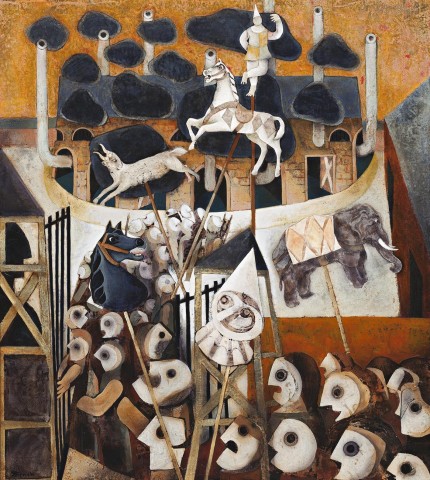THE ARRIVALS, 1981
LEONARD FRENCH
enamel on composition board
137.0 x 121.5 cm
signed lower left: French
Private collection
Sotheby's, Melbourne, 24 July 1988, lot 348 (as ‘The Animals’)
Private collection, Sydney
Leonard French: Dark Circus, Rudy Komon Art Gallery, Sydney, 8 August – 2 September 1981, cat. 2
From relative obscurity, Leonard French forged his own path to astonishing popularity. One of the most idiosyncratic talents in Australian art, French trained as a signwriter, while supplementing his training with part-time art classes. The artist was taken under the wing of Melbourne Technical College lecturer Victor Greenhalgh, who identified his prodigious talent and later gave French a teaching position. French was further captivated by the Melbourne art scene when he frequented the Swanston Family Hotel in Swanston Street after classes, an establishment also patronised by numerous emerging artists including Arthur Boyd, John Perceval, Clifton Pugh, Charles Blackman and John Olsen. The combination of his teaching and signwriting studies, together with regular debates among his artist peers at the Swanston Family Hotel (such congregations were later known as ‘Len French’s University’1), enabled French’s burgeoning artistic vision to solidify. From the late 1950s, French’s ascent was meteoric, winning in quick succession the Crouch, Perth, Peace Congress, Sulman and Blake prizes, the latter of which he won a second time in 1980.
While the Australian art scene in the late 1960s and 1970s was dominated by movements such as colour field abstraction, French, ever the isolate, plunged into the figurative idioms that defined his late work. Describing himself in 1981 as a ‘dog among the fairies’,2 French charged further into the dark allegories of captivity and death first established in his Death of a Revolution some years earlier. Exploring the rich subject of the circus, replete with dynamism and excitement yet undercut with melancholy and alienation, French embarked on his Dark Circus series, saturating all imagery with an advancing gloom.
’The metaphor of the circus of life has attracted many artists, from the carnivals of Bruegel and Ensor to the clowns and harlequins of Rouault, Léger and Picasso, and in Australian art the ballroom dancers of John Brack, the carnival scenes of John Perceval and the performance arena of Andrew Sibley's grand circus. French's arena is a circus of cut-out facades; among them are rocking horses, and toy elephants which he has appropriated from his daughter's picture books. Behind the facade lies the darkness…’3
In The Arrivals, 1981 people haul cut-out circus symbols toward a menacing furnace, reminiscent of the abandoned Hoffman Brickworks where the artist painted as a child. Beneath the spectacle of the ‘circus’ lies something ominous and frightening. The black smoke in the sky and the cavernous eyes of the crowd reflect the sombre emotions that had lingered in the artist’s imagination for some years. However, The Arrivals, 1981, bearing the luscious enamel surface favoured by the artist, does not sacrifice aesthetics for subject matter. In an interview with Jill Tobias in 1985, French explained: “Whatever I’ve got to say in a painting I still want the painting to be beautiful, to be a beautiful object, whatever the idea may be”.4 Owing no debt to other Australian artists of his time, French is a truly individual character in Australian art.
1. Heathcote, C., A Quiet Revolution: the rise of Australian art 1946-1968, Text Publishing, Melbourne, 1995, p. 63
2. ‘Leonard French, a man apart’, Weekend Australian, 18 – 19 April 1981
3. Grishin, S., Leonard French, Craftsman House, Sydney, 1995, p. 53
4. Tobias, J., ‘Leonard French, the Political Hermit’, Bendigo Advertiser, Victoria, 2 February 1985
MELISSA HELLARD
